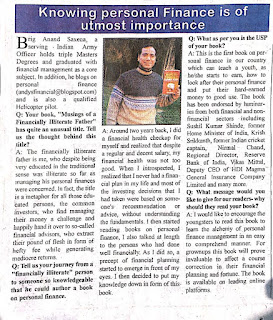PERSONAL FINANCE MUSING 33 THE BREATHING FUND
PERSONAL FINANCE MUSING 33 THE BREATHING FUND
I am back after a rather long hiatus which was for a noble cause though. I was busy working on my second book which is currently under editing. I will share the details with you over the coming weeks. Just as a teaser- the book is once again on personal finance, with a twist. Without further ado, let's begin the conversation of this post.
You must have heard of the Murphy’s Law which states, “Anything that can go wrong will go wrong.” I have invariably found it true in life situations and especially as far as my financial life is concerned, Mr Murphy will generally be accompanied by his cousins- debt and loan. Our epic scripture Bhagwat Gita states, “Whatever has to happen will happen,” but that does not absolve us from being prepared for Mr Murphy and his cousins. One easy way of doing it is by creating a "Breathing Fund", which allows you to sleep peacefully at night in spite of what life may throw at you financially.
Most of the financial experts agree
on this breathing fund
(also referred to as an Emergency Fund) to be large enough
to cover 3-6 months of one’s expenses. This is adequate to cater for unforeseen
emergencies like your bike or car needing major repairs or your AC packing up
in the middle of the summers. How should one go about creating this breathing
fund? Let's work along with our friend Anshreya, who is earning ₹50,000
per month; Remember, she is supposed to live on 80 percent of her income (wants
and needs) and save or invest the remaining 20 percent ( for details do read my Musing 5- Spending- Investing Balance). So
her 6 months expenses come to ₹2.4
lakhs
(6* ₹40,000.)
Now, till the time this breathing fund is built up to ₹2.4
lakhs,
Anshreya is not putting any money into her long-term savings but instead
socking this 20
percent to accumulate this fund.
She should be putting this money in a safe instrument like savings bank, Money
Market Account or liquid fund, from where she can access it within a day and at
the same time is assured of capital protection. We will be visiting all the available
financial instruments later.
Anshreya starts to put this 20 percent
money aside (₹10,000)
from the day she gets her first paycheck
and increases it by the inflation percentage (6 percent.) Assuming that the
financial instrument earns her a return of 4-5 percent, within
22-23 months (say two years,) her breathing fund is fully stocked up. Notice
what all this fund has achieved? It has inculcated a saving discipline in
Anshreya right from the beginning of her career which gives her a goal-based
focus, an important factor which will help her in future life. This solid asset
has given a spring in her steps and confidence in her life. Most importantly,
should any financial emergency strike her, she need not run for a credit card
or a personal loan – both
having prohibitive interest rates.
It is very important to define what
would constitute a financial emergency for which this breathing fund will be
used? Her parents’ marriage
anniversary will not be one because that falls on
a fixed date for which she should plan from her want
bucket, nor an annual vacation in Ladakh, which also should be a planned event
funded out of her
want bucket.
What happens when some real
financial situation arises where she needs to utilise
part of this breathing fund? She should immediately start to recoup it by
putting full or part of her 20
percent saving bucket towards it in a manner that it
gets recouped within 12-15 months. In this interim period, if required she must
pause her long-term
investments to attain short-term peace.
You would notice that the financial
instrument selected to build the breathing fund is providing higher
safety albeit with low rates of return. The breathing fund is for your peace of
mind and not a long-term investment, so you would not like it to be reduced to
half if the stock market tanks (which will invariably happen—remember Mr.
Murphy). So, be content with safety here even at the cost of growth.
Key Takeaways
·
A breathing fund,
catering to
3-6 months’ expenses, must be created the
one starts earning by putting the entire 20 percent
savings in a high safety and low-risk
financial instrument.
·
If exhausted for an emergency,
(define it deliberately for yourself), immediately take steps to recoup it even
at the cost of pausing your long-term investments.
This breathing fund obviates the need for a credit
card or personal loan.
That's it for this week.
See you next week with more information on my new book. Till that time enjoy my book, the link is below.


Comments
Post a Comment